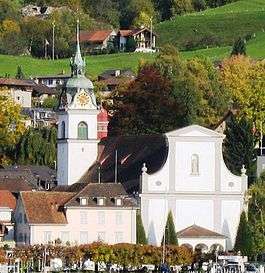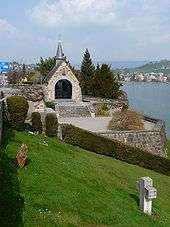Küssnacht
| Küssnacht | ||
|---|---|---|
 | ||
| ||
 Küssnacht | ||
|
Location of Küssnacht  | ||
| Coordinates: 47°4′N 8°26′E / 47.067°N 8.433°ECoordinates: 47°4′N 8°26′E / 47.067°N 8.433°E | ||
| Country | Switzerland | |
| Canton | Schwyz | |
| District | Küssnacht | |
| Government | ||
| • Mayor |
Bezirksammann Michael Fuchs | |
| Area[1] | ||
| • Total | 29.36 km2 (11.34 sq mi) | |
| Elevation (Hauptplatz, Küssnacht) | 441 m (1,447 ft) | |
| Population (Dec 2015[2]) | ||
| • Total | 12,423 | |
| • Density | 420/km2 (1,100/sq mi) | |
| Postal code | 6403 | |
| SFOS number | 1331 | |
| Localities | Küssnacht SZ, Immensee, Merlischachen | |
| Surrounded by | Greppen, Meggen, Adligenswil, Udligenswil, Meierskappel, Risch, Walchwil and Arth | |
| Twin towns | Küssaberg (Germany), Zduny (Poland) | |
| Website |
www SFSO statistics | |
Küssnacht am Rigi (official name since 2004: Küssnacht) is a village and a district and a municipality in the canton of Schwyz in Switzerland. The municipality consists of three villages Küssnacht, Immensee, and Merlischachen, the hamlet Haltikon, the industrial aea Fänn, and the alp Seeboden. It is situated at the north shore of Lake Lucerne and at the south shore of Lake Zug below mount Rigi (1,797 m (5,896 ft)).
History

Küssnacht is first mentioned around 840 as in Chussenacho though this is from an 11th Century copy of the original document. In 1179 it was mentioned as Chussenacho.[3]
In 1424 Küssnacht became a district of the Canton of Schwyz.
According to the legend of Wilhelm Tell, the hero shot the Austrian bailiff Gessler at the Hohle Gasse near the Gesslerburg with his crossbow:
"Here through this deep defile he needs must pass; there leads no other road to Küssnacht."
On August 29, 1935, Queen Astrid of the Belgians was killed here in a road accident. A memorial chapel ("Königin-Astrid-Kapelle") was built at the accident scene. On March 4, 1989, the chapel was demolished by youths, to be restored later that year.
The well known Klausjagen ("Nicholas chase") festival takes place in Küssnacht every year on the eve of St. Nicholas Day (December 5). The festival, attended by about 20,000 people, consists of a parade of around 1,000 participants, and lasts far into the night.
Geography
Küssnacht has an area, as of 2006, of 29.5 km2 (11.4 sq mi). Of this area, 57.5% is used for agricultural purposes, while 27% is forested. Of the rest of the land, 14.1% is settled (buildings or roads) and the remainder (1.4%) is non-productive (rivers, glaciers or mountains).[4]
The municipality is at the foot the Rigi mountain between the Lake of Lucerne and Lake Zug. It consists of the villages of Küssnacht, Immensee and Merlischachen as well as the hamlets of Haltikon and Seebodenalp.
It is the capital and only municipality of the district of Küssnacht.
Demographics
Küssnacht has a population (as of 31 December 2015) of 12,423.[5] As of 2007, 19.1% of the population was made up of foreign nationals.[6] Over the last 10 years the population has grown at a rate of 11.5%. Most of the population (as of 2000) speaks German (87.5%), with Albanian being second most common ( 2.7%) and Serbo-Croatian being third ( 2.7%).[4]
As of 2000 the gender distribution of the population was 50.5% male and 49.5% female. The age distribution, as of 2008, in Küssnacht is; 2,707 people or 25.3% of the population is between 0 and 19. 3,168 people or 29.6% are 20 to 39, and 3,406 people or 31.8% are 40 to 64. The senior population distribution is 775 people or 7.2% are 65 to 74. There are 477 people or 4.5% who are 70 to 79 and 171 people or 1.60% of the population who are over 80. There are 3 people who are over 100 years old in Küssnacht.[6]
As of 2000 there are 4,377 households, of which 1,387 households (or about 31.7%) contain only a single individual. 271 or about 6.2% are large households, with at least five members.[6]
In the 2007 election the most popular party was the SVP which received 36.3% of the vote. The next three most popular parties were the CVP (25.6%), the FDP (21.6%) and the SPS (12.1%).[4]
The entire Swiss population is generally well educated. In Küssnacht about 72.9% of the population (between age 25-64) have completed either non-mandatory upper secondary education or additional higher education (either university or a Fachhochschule).[4]
Küssnacht has an unemployment rate of 1.62%. As of 2005, there were 344 people employed in the primary economic sector and about 125 businesses involved in this sector. 2,340 people are employed in the secondary sector and there are 153 businesses in this sector. 3,135 people are employed in the tertiary sector, with 486 businesses in this sector.[4]
From the 2000 census, 7,891 or 73.7% are Roman Catholic, while 1,152 or 10.8% belonged to the Swiss Reformed Church. Of the rest of the population, there are less than 5 individuals who belong to the Christian Catholic faith, there are 146 individuals (or about 1.36% of the population) who belong to the Eastern Orthodox Church, and there are 17 individuals (or about 0.16% of the population) who belong to another Christian church. There are less than 5 individuals who are Jewish, and 501 (or about 4.68% of the population) who are Islamic. There are 76 individuals (or about 0.71% of the population) who belong to another church (not listed on the census), 563 (or about 5.26% of the population) belong to no church, are agnostic or atheist, and 354 individuals (or about 3.31% of the population) did not answer the question.[6]
The historical population is given in the following table:[3]
| year | population |
|---|---|
| 1743 | 1,506 |
| 1799 | 1,987 |
| 1850 | 2,788 |
| 1900 | 3,562 |
| 1950 | 5,680 |
| 1970 | 7,956 |
| 1980 | 8,203 |
| 1985 | 8,676 |
| 1990 | 9,437 |
| 2000 | 10,908 |
| 2005 | 11,639 |
| 2007 | 11,870 |
References
- ↑ Arealstatistik Standard - Gemeindedaten nach 4 Hauptbereichen
- ↑ Swiss Federal Statistical Office - STAT-TAB, online database – Ständige und nichtständige Wohnbevölkerung nach institutionellen Gliederungen, Geburtsort und Staatsangehörigkeit (German) accessed 30 August 2016
- 1 2 Küssnacht in German, French and Italian in the online Historical Dictionary of Switzerland.
- 1 2 3 4 5 Swiss Federal Statistical Office accessed 31-Aug-2009
- ↑ Swiss Federal Statistical Office - STAT-TAB, online database – Ständige und nichtständige Wohnbevölkerung nach institutionellen Gliederungen, Geburtsort und Staatsangehörigkeit (German) accessed 30 August 2016
- 1 2 3 4 Canton Schwyz Statistics (German) accessed 27 August 2009
External links
| Wikimedia Commons has media related to Küssnacht. |
| Wikivoyage has a travel guide for Küssnacht. |
